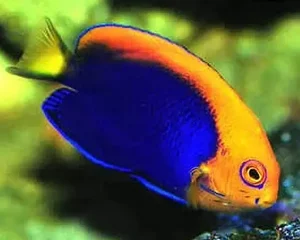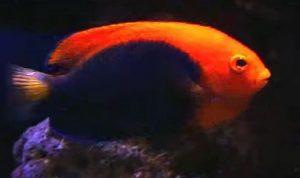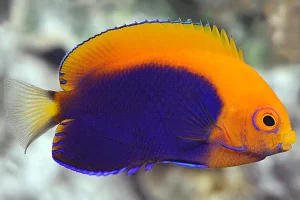The African Flameback Angelfish (Centropyge acanthops) known to tropical fish keeping enthusiasts as the Orangeback Pygmy Angelfish, African Pygmy Angelfish, or Fireball Pygmy Angelfish occurs from East and South Africa and the Arabian Gulf in the Western Indian Ocean.
African Flameback Angelfish are a shy dwarf species that are found at depths between 35 and 135 feet along rock and coral rubble areas of the reef where they feed primarily on algae and sponges. They are commonly found around heavy growths of algae alone or in small groups of one male with three or more females, and often several juveniles.
African Flameback Angelfish (Centropyge acanthops) are similar in color and shape to the Brazalian Flameback Angelfish (Centropyge aurantonotus) and the Cherub Pygmy Angel (Centropyge argi); the most obvious difference being the caudal fin which is yellow and somewhat transparent. The Brazilian Flameback Angelfish or Fireball Angelfish has a blue caudal fin.
African Flameback Angelfish aka Orangeback Angelfish have an oval, laterally compressed body with a short snout and a small mouth. They have a dark blue body with a broad bright orange to golden yellow swatch that proceeds from the face, along the back to the tip of the dorsal area. The eyes are circled in blue .
Visual determination of sex is not possible based on coloration but since Centropyge acanthops are protygenous hermaphrodites, larger individuals are presumed to be males.
All Centropyge species begin their adult life as females and within a few days to a couple of weeks, the larger or more dominant individual within a small group will change sex and become a male. When two fish are placed together, in approximately sixty days one of the two fish will physically changed their sex to accommodate the other. If need arises, a reversal is possible but it takes weeks to months to transpire.
Although African Flameback Angelfish are suited for reef tanks and may occasionally nip clam mantles, sea anemones, large polyp stony (LPS) corals, and some soft corals such as zoanthids, they normally do not bother non-sessile invertebrates like crabs or shrimp.
African Flameback Angelfish are best housed in a mature reef or fish only aquarium of at least 55 gallon capacity with plenty of live rock for grazing on microalgae, diatoms, and accumulations of detritus; arranged into caves, crevices, and overhangs for them to hide among. A shy species, they require multiple hiding spaces until they establish a territory and feel secure enough to come out into the open areas of the tank.
No successful breeding’s of the African Flameback Angelfish in an aquarium environment have been reported.
Like other angelfish species, Centropyge acanthops lays pelagic eggs and has pelagic larvae. The spawning ritual occurs at dusk and the eggs are left to float in the water column.
In the wild, African Flameback Angelfish feed on algae, sponges, accumulations of detritus, etc. They are excellent browsers of filamentous algae and the tiny organisms that live in the algae. In an aquarium environment, their diet should include a variety of meaty foods including Spirulina, marine algae, a high quality commercial angelfish preparation, and Mysis or frozen shrimp. Spirulina flakes or pellets are also accepted. This species should be fed small amounts three times or more a day, even with natural foods present.
Although not common, African Flameback Angelfish (Centropyge acanthops) are available to tropical fish keeping enthusiasts from a variety of sources online and from local tropical fish shops. Although they are a captively bred species and are less expensive and more readily available than Brazilian Flameback Angelfish, they are rarely available in the aquarium trade.
African Flameback Angelfish (Centropyge acanthops) in the 1.25″-2.5″ size will cost about $120.00 vs $300.00 for the same size Brazalian Flameback.
Minimum Tank Size: 55 gal
Aquarium Type: Reef compatible with caution
Care Level: Moderate
Temperament: Semi Aggressive
Aquarium Hardiness: Hardy
Water Conditions: 72 to 78°F, dGH 8-12, sg 1.023-1.025, pH 8.1-8.4,
Max. Size: 3″
Color Form: Blue, Orange
Diet: Omnivore
Compatibility: Reef compatible with caution
Origin: Africa
Family: Pomacanthidae
Lifespan: 5-8 years
Aquarist Experience Level: Intermediate





My African flameback lived 21 years with me and a yellow tang that still thrives after 22 years. A sulphur reactor has helped with water quality as my tang would turn pale and become skittish at about 6-8 week intervals. but responded to water and filter changes. He or she obviously didn’t like higher nitrates. The flameback seemed unaffected and was generally a hardy fish. Of course I’ve made mistakes and had premature deaths too, but a yellow tailed blue damsel went 19 years and a swallow tail damsel for 15 ,